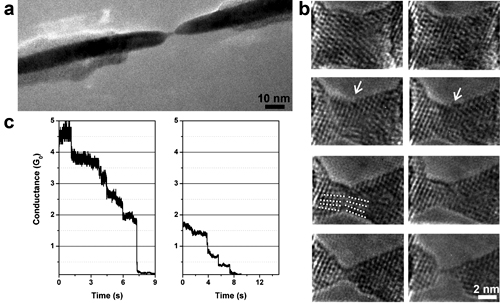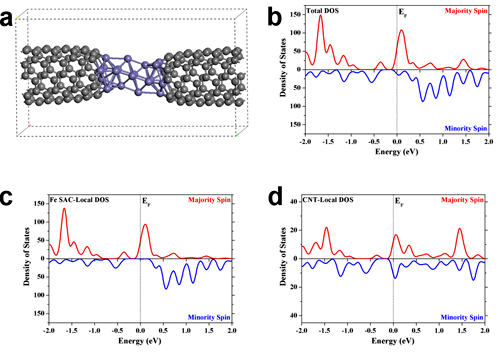Metal atomic chain (MAC) is an ultimate one-dimensional structure with unique physical properties, such as quantized conductance and quantized magnetoresistance. Therefore, MACs are anticipated to find applications in nanoscale electronic and spintronic devices. However, the fabrication of MACs is very difficult and the fabricated MACs are usually held between two macro-scale electrodes. Thus, how to connect and integrate these extremely small MACs when assembling nanodevices remains a challenge. DM Tang, Li-Chang Yin, Hui-Ming Cheng, Chang Liu at Institute of Metal Research, Chinese Academy of Sciences (IMR, CAS), Young-Hee Lee at Sungkyunkwan University, and co-workers1 designed and fabricated a unique carbon nanotube (CNT)-clamped MAC, providing an feasible way for the interconnection and integration of MACs.
The CNT-clamped MAC is prepared by in situ machining a metal filled CNT, including peeling off carbon shells by spatially and elementally selective electron beam irradiation and further elongating the exposed metal nanowire. The microstructure and formation process of the CNT-clamped MAC were explored by both in situ high resolution transmission electron microscopyand theoretical simulations. First-principles calculations indicate that strong covalent bonds are formed between the CNT and MAC, and the connected Fe ACs are half-metallic. In addition, quantized conductance of the nanostructure is demonstrated by in situ electrical transport measurements.
The strategy the authors proposed is effective in fabricating a variety of MACs and in situ connecting these MACs with CNTs, thus it may find potential applications in the assembly of nano/sub-nano devices.

Figure 1 Fabrication process and electrical properties of a CNT-clamped Fe AC. (a) Low-magnification TEM image of the CNT-clamped Fe AC. (b) High resolution TEM images showing the formation process of the Fe AC. (c) Conductance changes as a function of time for two formation and thinning processes of Fe ACs at a constant bias of 12 mV.

Figure 2 Simulated structural model and the calculated density of states of the CNT-clamped Fe AC. (a) Fully relaxed ball-and-stick model of a CNT-clamped Fe AC. (b) Spin resolved total DOS for the CNT-clamped Fe AC. (c) and (d) Spin resolved local DOS of the Fe AC and CNT.
Reference
1. Tang, D.-M.; Yin, L.-C.; Li, F.; Liu, C.; Yu, W.-J.; Hou, P.-X.; Wu, B.; Lee, Y.-H.; Ma, X.-L.; Cheng, H.-M., Carbon nanotube-clamped metal atomic chain. Proceedings of the National Academy of Sciences 2010, 107 (20), 9055-9059.